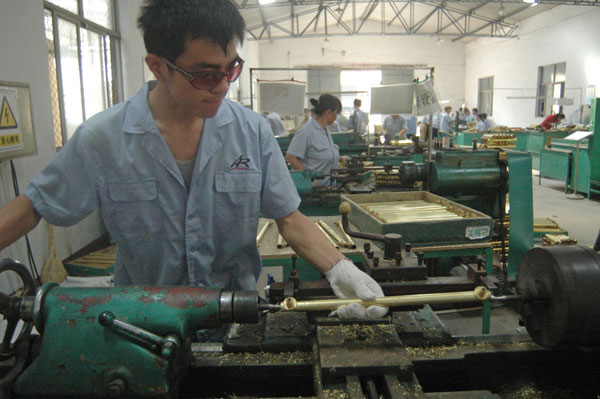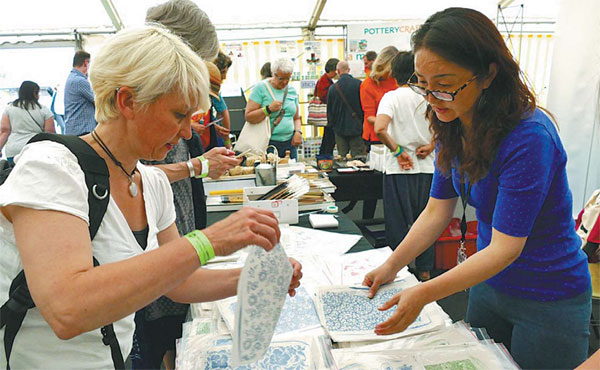Happy potters all fired up about ancient Chinese porcelain
Updated: 2015-08-14 08:53
By Peng Yining(China Daily Europe)
|
|||||||||||
Ceramics artists in the UK are looking back to China's 'golden age' of pottery and finding plenty of inspiration for a range of new, experimental works
A thick layer of clay dust coats Jessie Lee's work tables and shelves. Her studio abounds with vases and pots, but pride of place goes to a ceramic candlestick decorated with lotus flowers and a Chinese dragon coiled around the neck.
"I've kept it for 40 years. It was my first piece of work," says the 67-year-old Malaysian-born British ceramics artist, speaking at her studio in High Wycombe on the outskirts of London.
|
Left: British ceramics artist Jessie Lee and her first work of pottery, a candlestick she made 40 years ago. Right: Mia Sarosi, a ceramics artist based in Oxfordshire, and her blue and white porcelain works at an exhibition at Art in Action at Waterperry Gardens. Photos by Peng Yining / China Daily |
|
An operator of a ceramic art gallery from Jingdezhen shows visitors Chinese designs used for making ceramics at an exhibition during the International Ceramics Festival in July at Aberystwyth on the coast of West Wales. Christine Payne for China Daily |
"My teacher told me to make something, so I made the dragon candlestick. The Chinese influence was strong when I started to learn about pottery in the 1970s," she says, contemplating the dragon with its piercing claws, surrounded by trailing clouds.
Made from a material that was virtually unknown in Europe until the 1500s, Chinese porcelain caused a sensation in 16th-century Europe, and collecting fine works become popular among the wealthy. By the 18th century the fever had spread to others.
Chinese porcelain, especially the famous blue and white ware, changed people's ideas of beauty, and the enormous demand encouraged European potters to try to replicate art works from the East. The influence of Chinese ceramics continues to inspire artists to this day.
"Chinese porcelain is extremely famous in the West, especially the wares made in Jingdezhen. Almost the entire collection of Chinese porcelain in the British Museum was made in Jingdezhen," Lee says, referring to China's ceramics capital in Jiangxi province. "For British potters, Jingdezhen is the place."
When she visited the ancient city in 2011, Lee was impressed to discover that the ancient pottery-making skills hadn't died out. She saw a man coil a pot simply by walking around the vessel.
"The pot was nearly a meter tall and too big for the wheel, so the man held a lump of clay and moved around at a certain pace so that it looked like he was dancing around the pot," she says. "It was an old way of making pots and was very beautiful. I was inspired and made a smaller coiled pot when I came back."
Last year, Lee returned to Jingdezhen for more inspiration. This time, she cut clay with a stretched coil spring to produce shapes such as waves and ripples.
"The local landscape inspired me. I could hear and see the streams the whole day and the whole night," she says. "Traditional Chinese artists also observe nature and then return to their studios to work."
Ancient and modern
The Sanbao Ceramic Art Institute, a private art center in a suburb of Jingdezhen, receives more than 200 foreign artists every year, including about a hundred who arrive to work as artists in residence. Many of them come from the United Kingdom, says Li Wenying, the institute's manager.
When Li attended the International Ceramics Festival, held in July at Aberystwyth on the coast of West Wales, the Chinese artwork and handmade pottery tools she took along attracted huge interest.
"During the three-day event, my stand was crowded all the time. People were asking me about Jingdezhen and traditional Chinese skills," she says.
"In 2013, I was invited to give a speech on our institution and Jingdezhen's ceramic arts at the festival. Next time, I hope to bring more Chinese potters to the UK's leading ceramics event."
After Jingdezhen's potters discovered the secret of making porcelain during the Song Dynasty (960-1279), the material became one of China's earliest and most-important global commodities, and helped introduce Chinese culture, art and the name of the city to the world. Even today, Jingdezhen is a byword for ceramics.
Although the industry has modernized and many of the old processes are now performed by machines, the city's ancient kilns and skills have been lovingly preserved.
Built during the Qing Dynasty (1644-1911), the 40-meter-long Zhenyao is in the Guinness Book of World Records as the world's largest wood-burning kiln, and it is still regularly used to fire porcelain.
In 2005, a blue and white jar that had been fired in Huluyao - another active ancient kiln in Jingdezhen - during the Yuan Dynasty (1271-1368), sold for $34 million at an auction in London.
"For ceramic artists, Jingdezhen is like a gold mine - there are so many things to learn. An ordinary old man walking on the street might be a master of the wood-burning kiln," Li says, adding that in the UK, ceramists focus on having good ideas, but very few of them understand glazes and related skills, including throwing, coiling and painting.
Inspired by nature
Mia Sarosi, a ceramics artist based in Oxfordshire, England, made a flat-bottomed bowl decorated with a dragon pattern for an exhibition at Art in Action, one of the UK's largest annual art events, held at Waterperry Gardens in Oxfordshire.
When she was making the work, Sarosi constantly scrutinized the dragons seen on Chinese porcelain from the Ming Dynasty (1368-1644) because she is interested in the positive symbolism of the mythical beasts in both Eastern and Western cultures.
"For the Art in Action show in July, I used gold luster for the dragon's flames. I'm aware that in China gold is a color that's used a lot in celebrations," says the artist, who began working with ceramics in 1991.
Many of her works are inspired by Chinese blue and white ware, but she also tries to incorporate her own ideas. For a blue and white plate she presented at the event, Sarosi painted long tailed tits and a cherry tree - the view outside her window.
"I was inspired by the cherry trees in A.E. Houseman's poem, Loveliest of Trees, the Cherry Now," she says.
Although first taught and inspired by Chinese potters, British artists have developed their own styles. In the 18th century, when hand-painted blue and white Chinese porcelain was fashionable and expensive, British potters created an affordable alternative by printing their designs onto earthenware. They also created the famous "willow pattern" motif by combining elements from several different Chinese patterns to produce a new design.
Innovation
In the Potteries Museum and Art Gallery in Stoke-on-Trent, Staffordshire, the home of the English pottery industry, early imitations of Chinese porcelain are displayed alongside original works by Josiah Wedgwood, an innovative designer who improved the UK's ceramics industry by incorporating new materials.
Wedgwood's Jasperware, made from white stoneware clay and colored with metal oxides, was decorated experimentally with white relief portraits or scenes from ancient Greek classics.

"In the West, people focus more on innovation than craftsmanship," says Christine Ann, a 70-year-old ceramics artist from Somerset in western England, who believes British potters are innovative and eager to produce original work.
In 1978, Ann was a member of the first group of UK ceramic artists to visit China, and she says the trip had a radical effect on her work.
Ann says some of her monochrome porcelain, such as white plates with spontaneous brush strokes in black, was inspired by Chinese calligraphy, which she has loved since her trip to China. "But I never copy anything. I am very much a maker," she says.
Those sentiments were echoed by Lee, the ceramics artist from High Wycombe: "I don't borrow ideas from Chinese ceramics. The philisophy behind the work is the thing I'm most eager to learn."
pengyining@chinadaily.com.cn
|
Above: An old kiln in Stoke-on-Trent, Staffordshire, the home of the English pottery industry. Below: Ceramics made by local people in the 18th century at a museum in Stoke-on-Trent shows Chinese influence. Photos by Peng Yining / China Daily |

|
From top: A Chinese student learns to use a robotic arm to make ceramics in the UK; Peter T. Stokes (left) has operated a clay factory in Stoke-on-Trent for about 50 years - his clay products supply ceramics artists around the world; Dan Tyler, a worker in Stoke-on-Trent, examines the hardness of clay. Photos by Peng Yining / China Daily |
(China Daily European Weekly 08/14/2015 page6)
Today's Top News
Turkey's early elections 'decidedly possible': PM
Death toll rises to 50, military sends chemical specialists to blast site
12 firefighters among 44 killed in explosions
Chinese yuan extends fall Thursday
China rattles a few cages in the world's financial markets
Tibetan drivers to finally see the end of 'death road'
China becomes world's largest robots market for second consecutive year
Yuan may stumble, but will not fall
Hot Topics
Lunar probe , China growth forecasts, Emission rules get tougher, China seen through 'colored lens', International board,
Editor's Picks

|

|

|

|

|

|










